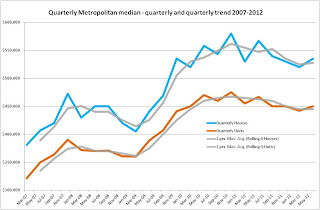Some journalists have got confused by the REIV's statement that median Melbourne property prices were mostly unchanged during the June quarter when the actual results show strong price rises (see the table below). I quickly tweeted a response that this was likely a function of averaging through the six months in which the June quarter gains would have cancelled out the March quarter losses. So it proves.
Enclosed below are the official median data from the REIV and a chart that shows both the quarterly price movements (the more volatile blue and orange lines) and the two-quarter (or six monthly) moving average (the smoother grey lines).
You can see that in Melbourne both detached house and unit prices rose sharply in the June quarter (orange and blue lines), based on the REIV data. However, if you average over the period January through June (ie, over the last six months) prices have moved sideways (grey line). So while house prices fell during March quarter they have been rising during the subsequent three months, based on this data.
Real-time, stream-of-consciousness insights on financial markets, economics, policy, housing, politics, and anything else that captures my interest. Tweet @cjoye
The author has been described by News Ltd as an "iconoclast", "Svengali", a pollie's "economist muse", and "pungently accurate". Fairfax says he is a "Renaissance man" and "one of Australia’s most respected analysts." Stephen Koukoulas concludes that he is "85% right", and "would make a great Opposition leader." Terry McCrann claims the author thinks "‘nuance’ is a trendy village in the south of France", but can be "scintillating" when he thinks "clearly". The ACTU reckons he’s "an enigma wrapped in a Bloomberg terminal, wrapped in some apparently well-honed abs."

